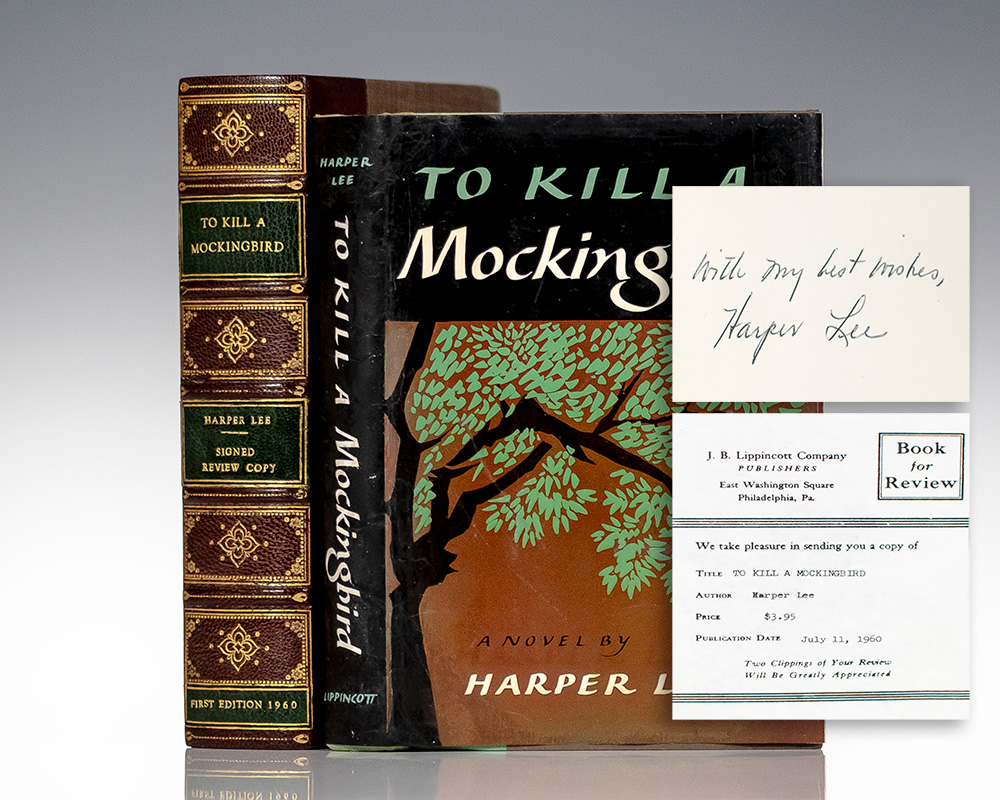To Kill A Mockingbird.
First edition of Harper Lee's To Kill A Mockingbird; with an autograph note signed by her
To Kill A Mockingbird.
LEE, Harper.
$27,500.00
Item Number: 139543
Philadelphia & New York: J. B. Lippincott Company, 1960.
First edition of one of the most important American novels of the 20th century which had an initial first printing of 5,000 copies and went on to earn Harper Lee the 1961 Pulitzer Prize for fiction. Octavo, original half cloth. With an autograph postcard signed by and entirely in the hand of Harper Lee laid in. Addressed to Stewart Richardson, Executive Editor of Doubleday & Company, the postcard reads in full, “Monroeville, Ala. September 5, 1970 Dear Sandy: No, I didn’t receive galleys on James Purdy’s – but I’d like to. They’re probably sitting in New York somewhere. I’ll be back by the first of October, but if you need a quote before then, please send galleys to Monroeville, zip 36460. Best, Nelle.” Following the publication of To Kill a Mockingbird in 1960, Lee became increasingly reclusive, granting almost no requests for interviews or public appearances and, with the exception of a few short essays, publishing nothing further until 2015. 40 years, she lived part-time at 433 East 82nd Street in Manhattan, near her childhood friend Truman Capote, but tensions grew between them with the publication of Capote’s In Cold Blood and his growing penchant for a decadent lifestyle, which contrasted with Lee’s preference for a quiet, more anonymous existence. At the time of this correspondence with Doubleday, Lee had begun to spend more time in Monroeville, where she had assumed significant care responsibilities for her aging father. Near fine in a very good dust jacket. Jacket design by Shirley Smith. Author photograph by Truman Capote. Housed in a custom half morocco clamshell box made by the Harcourt Bindery.
Four years after the publication of To Kill a Mockingbird, Lee remarked, "I never expected any sort of success with Mockingbird. I was hoping for a quick and merciful death at the hands of the reviewers, but at the same time I sort of hoped someone would like it enough to give me encouragement. Public encouragement. I hoped for a little, as I said, but I got rather a whole lot, and in some ways this was just about as frightening as the quick, merciful death I'd expected." Based on Lee's experiences growing up in the Deep South, the primary themes of the novel involve racial injustice and the destruction of innocence with Atticus Finch, the narrator's father, serving as a moral hero for many readers and as a model of integrity for lawyers. The story, told by the six-year-old Jean Louise "Scout" Finch, takes place between 1933 and 35 and follows the story of a local black man, Tom Robinson, who has been accused of raping a young white woman. Appointed to defend him, Atticus Finch establishes Robinson's innocence and a devious plot to convict him by a local white couple. Despite her editors' warnings that the book might not sell well, it quickly became a sensation, bringing acclaim to Lee in literary circles, in her hometown of Monroeville, and throughout Alabama. The New Yorker declared it "skilled, unpretentious, and totally ingenious". It has gone on to become of the best-loved classics of all time and has been translated into more than forty languages selling more than forty million copies worldwide.













